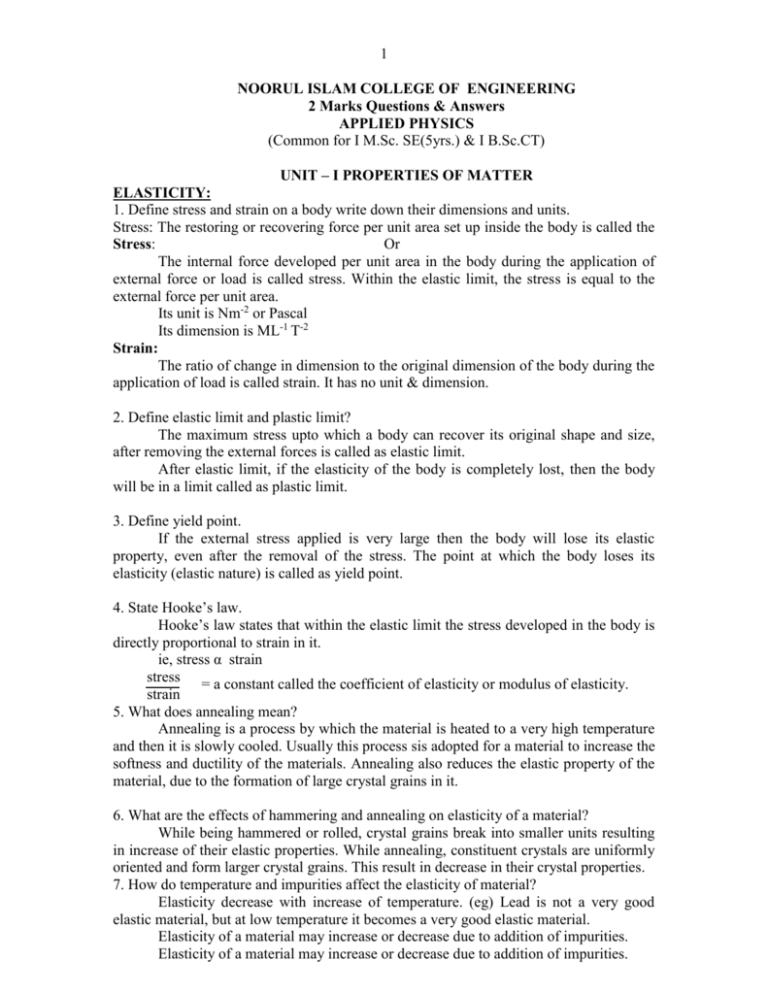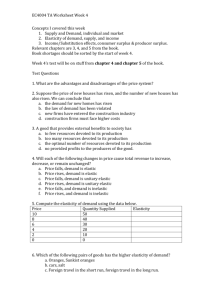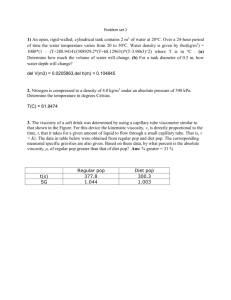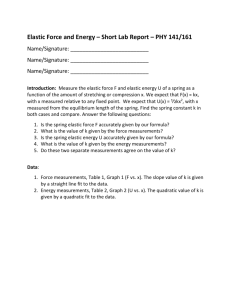applied physics
advertisement

1 NOORUL ISLAM COLLEGE OF ENGINEERING 2 Marks Questions & Answers APPLIED PHYSICS (Common for I M.Sc. SE(5yrs.) & I B.Sc.CT) UNIT – I PROPERTIES OF MATTER ELASTICITY: 1. Define stress and strain on a body write down their dimensions and units. Stress: The restoring or recovering force per unit area set up inside the body is called the Stress: Or The internal force developed per unit area in the body during the application of external force or load is called stress. Within the elastic limit, the stress is equal to the external force per unit area. Its unit is Nm-2 or Pascal Its dimension is ML-1 T-2 Strain: The ratio of change in dimension to the original dimension of the body during the application of load is called strain. It has no unit & dimension. 2. Define elastic limit and plastic limit? The maximum stress upto which a body can recover its original shape and size, after removing the external forces is called as elastic limit. After elastic limit, if the elasticity of the body is completely lost, then the body will be in a limit called as plastic limit. 3. Define yield point. If the external stress applied is very large then the body will lose its elastic property, even after the removal of the stress. The point at which the body loses its elasticity (elastic nature) is called as yield point. 4. State Hooke’s law. Hooke’s law states that within the elastic limit the stress developed in the body is directly proportional to strain in it. ie, stress α strain stress = a constant called the coefficient of elasticity or modulus of elasticity. strain 5. What does annealing mean? Annealing is a process by which the material is heated to a very high temperature and then it is slowly cooled. Usually this process sis adopted for a material to increase the softness and ductility of the materials. Annealing also reduces the elastic property of the material, due to the formation of large crystal grains in it. 6. What are the effects of hammering and annealing on elasticity of a material? While being hammered or rolled, crystal grains break into smaller units resulting in increase of their elastic properties. While annealing, constituent crystals are uniformly oriented and form larger crystal grains. This result in decrease in their crystal properties. 7. How do temperature and impurities affect the elasticity of material? Elasticity decrease with increase of temperature. (eg) Lead is not a very good elastic material, but at low temperature it becomes a very good elastic material. Elasticity of a material may increase or decrease due to addition of impurities. Elasticity of a material may increase or decrease due to addition of impurities. 2 (eg) Addition of carbon in minute quantity to milten iron, increases the elastic property enormously. But the carbon content is more than 1% in iron, then the strength of iron decreases. 8.What do you infer from stress-strain curve? The elastic behaviour of a material of wire can be studied by plotting a curve between the stress along the y-axis and the corresponding strain on the x-axis. The curve is called stress-strain curve A proportional limit A1 Elastic limit B Yield point C Ultimate tensile strength D Breaking stress Strain From the stress-strain diagram, we can infer the following points. (i) The stress is directly proportional to the strain, within the elastic limit. (ii) It distinguishes the elastic and plastic limit of a material (iii) It determines the ultimate strength of the material (iv) The stress-strain diagram also helps us to distinguish the material based on the properties such as ductility & brittleness. 9. What are the uses of stress-strain curve? (1) It is used to determine the elastic strength, yield strength, ultimate tensile strength and compressive strength of an engineering material. (2) It is useful to identify the material as ductile or brittle or hard. (3) One can study the effect of heat treatment on the improvement of mechanical properties using stress-strain curve. (4) For manufacturing the engineering products, one can determine the amount of energy required to deform the material elastically or plastically. 10. What are shaft? A shaft is a component of a machine, which is used to transmit the power from the source to a load. Any rotating member which is transmitting torque is called shaft. Eg. In flourmill, the power transmission shaft is used to transmit the power developed in the motor to the machine through a belt. 11. What are the requirements of a good shaft? (1) The shaft should transmit the couple without any appreciable twist in it. (2) Twist in the shaft should be very small even far large couple. (3) It is preferable to use shafts of large radius and high rigidity modulus since the efficiency of a shaft varies as (4) Hollow shaft is comparatively stronger than the solid shaft of same dimension. 12. Explain neutral axis. In the middle of the beam, there is a layer which is not elongated the beam or comprised due to bending of the beam. This layer is called the ‘neutral surface’ and the line at which the neutral layer intersects the plane of bending is called ‘neutral axis’ 13. Define Cantilever. A Cantilever is a beam fixed horizontally at one end and loaded at the other end. 3 14. What is an I-shaped girder? A girder is a metallic beam supported at its two ends by pillars or on opposite walls. It should be so designed that should not bend too much or break under its own weight. 15. Why do we prefer I - shape girder rather than solid girders? I shaped girder are preferred because they are cheaper than solid girders due to usage of lesser amount of material for making I shape girders with no loss in strength. Secondly due to their low weight it would not undergo depression by its weight and due to their larger depth, the depression produced is almost negligible which enhances the life of the girder. HIGH VACUUM TECHNOLOGY 16. Mention the role of high Vacuum technology? High vacuum technology plays an important role in the field of mass spectroscopy, electron physics, surface physics, manufacturing of solid-state electron devices and Vacuum metallurgy. 17. Give the different levels of Vacuum and how that is produced? Pressure level Production (Torr) 1) Vacuum 1 Rotary Pump 2) High Vacuum 10-6 Diffusion Pump 3) Ultra high Vacuum 10-10 Sorption Pump 18. What is principle employed in Cenco rotary pumps? The gas or air inside the vessel is compressed and forced out by continuously by rotating the rotor until a high vacuum is produced in the vessel which is connected to the pump. 19. Give the principle employed in mercury diffusion pump? Mercury diffusion pump works under the principle of diffusion of air which occurs from the high pressure region to low pressure region. The diffused air is carried by mercury vapour and hence called as mercury diffusion pump. 20. Mention the instruments to measure and produced vacuum Manometer and Gauges are used to measure vacuum (i) Manometer (a) Mercury Manometer – Eg Mc Leod Gauge (b) Mechanical Manometer – Eg Bourdon spiral Gauge. (c) Viscosity Manometer – Eg Langmuir and Dushman’s molecular Gauge (ii) Gauges (a) Radiometric Gauges (b) Conductivity Gauges (c) Loanization Gauges (d) Effusion Gauges Types of pumps used to produce vacuum are mechanical pump, chemical pump, sorption pump cryo pump and vapour stream pump. 4 21. Give the principle of Pirani Gauge It is known that at high pressure, the thermal conductivity (K) of a gas is independence lower than 10-2 mm of Hg, the mean free path of the gas molecules increases and the thermal conductivity is directly proportional to the pressure (P). Therefore the amount of heat last per second due to thermal condition is directly proportional to the pressure. 22. What is the Principle behind Pirani Gauge It is known that at high pressure, the thermal conductivity (K) of a gas is independence lower than 10-2 mm of Hg, the mean free path of the gas molecules increases and the thermal conductivity is directly proportional to the pressure (P). Therefore the amount of heat last per second due to thermal condition is directly proportional to the pressure. VISCOSITY 23. Define Coefficient of Viscosity and viscous force. Coefficient of viscosity of a liquid is defined as the tangential force acting per unit area of the liquid when there is a unit velocity gradient between two layers of the flowing liquid. Its unit is Ns-m-2 Viscous force is the resisting force for the fluid flow. It is always acting in the opposite direction of the flow. So that, it is similar to the frictional force Viscous force, F = η A V1 – V2 Newtons x 24. Discuss the variation of viscosity with temperature. Generally the Viscosity of a liquid decreases with the rise of temperature such that log ηT = a + b T Where a and b are constants for a given liquid. 25. Discuss the variation of viscosity with pressure. For moderate pressure the viscosity of a gas is found to be independent of pressure. At low pressures the coefficient of viscosity of gases is proportional to pressure. The viscosity of liquids in general increases with the increase of pressure. In the case A water, however at atmospheric temperature, there is a decrease in viscosity for the first few hundreds atmospheres. The effect of pressure for most of the liquid excepting water increases at higher pressures. 26.Define stream line flow and turbulent flow. A streamline flow is one which all the particles of the liquid move in an orderly procession, and the path of every particle is the same as that of the liquid as a whole In turbulent flow, the velocity of the liquid is not constant at every point and its magnitude is large. The flow is highly irregular. The driving force of the liquid is large. 27. Define Critical velocity of fluid. Critical velocity is the velocity at which the steady or steamline flow changes into turbulent flow. In other words, above the critical velocity, the liquid motion is turbulent and below which the liquid is in streamline. Critical velocity = Vc = kη ρ r. 5 28. What is Reynold’s number? Give its importance Reynolds number ‘k’ is a dimensionless constant and is used t6o determine whether the liquid flow through a tube or pipe is stream lined or turbylent. K = Vc ρr η Where Vc is the critical velocity of the liquid, p is the density of the liquid and r is the radius of the tube or pipe. For example If r = 1cm, then we have water flow through that tube is streamlined lined if k<2000 If k>2000, then the water flow is turbulent. 29.Differentiate between streamline flow and turbulent flow. Stream line flow Turbulent flow 1. Each particle in the liquid moves in The particles moves in different the same path and has same directions and with different velocities velocity as that of its preceding 2. particle The flow is in a Zig-Zag path The flow is regular(steady flow or 3. orderly flow) The velocity is not constant and it The velocity is constant at every exceeds the critical velocity pint and does not exceed the 4. critical velocity It causes eddies and whirlpools. It does not cause eddies or whirl Eg. Flow of water while drinking pools eg. Flow of liquid through capillary tube 30.How will you compare the Viscosities of two liquids? Orwals Viscometer is used for comparing the Viscosities of two liquids. 31. What is the principle of Orwald Viscometer? Equal volume of the liquids whose viscosities are to be compared are allowed to flow through the capillary tube. The their viscosity are compared by comparing the rate of flow of the liquid with capillary tube and by using the Porseuille’s formula V = ηh ρgr4 t 8ηl Where V – Volume of the liquid. r – radius of the capillary tube l – length of the capillary tube η -Viscosity of the liquid ρ - Density of the liquid gAcceleration due to gravity h - Height of the liquid above the axis of the capillary tube.









